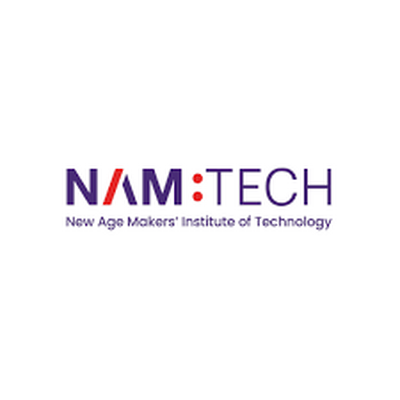Notifications
ALL BUSINESS
COMIDA
DIRECTORIES
ENTERTAINMENT
FINER THINGS
HEALTH
MARKETPLACE
MEMBER's ONLY
MONEY MATTER$
MOTIVATIONAL
NEWS & WEATHER
TECHNOLOGIA
TV NETWORKS
VIDEOS
VOTE USA 2026/2028
INVESTOR RELATIONS
DEV FOR 2025 / 2026
ALL BUSINESS
COMIDA
DIRECTORIES
ENTERTAINMENT
FINER THINGS
HEALTH
MARKETPLACE
MEMBER's ONLY
MONEY MATTER$
MOTIVATIONAL
NEWS & WEATHER
TECHNOLOGIA
TV NETWORKS
VIDEOS
VOTE USA 2026/2028
INVESTOR RELATIONS
DEV FOR 2025 / 2026
About Me
 NAMTECH Institute
NAMTECH Institute New Age Makers Institute of Technology (NAMTECH), an Education Initiative of Arcelor Mittal Nippon Steel India (AM/NS India), strives to offer a forward-thinking approach to engineering education, preparing students for the challenges and opportunities presented by the dynamic landscape of Industry 4.0 technologies. Our campus at Research Park, IIT Gandhinagar serves as a hub for excellence, fostering innovation, research, and the development of skills that align with the needs of the evolving industry. NAMTECH’s approach to Inspiring Human Capital is based on the three pillars of: 1. Make It Yourself 2. Industry Aligned Programs 3. Teaching Global Values
 NAMTECH Institute -
Tue at 8:07 AM -
Technology -
50 views -
0 Comments -
0 Likes -
0 Reviews
NAMTECH Institute -
Tue at 8:07 AM -
Technology -
50 views -
0 Comments -
0 Likes -
0 Reviews

Chips quietly run the world around us. They're in your mobile, your car, and yes, even that smart fridge in your kitchen. You don’t see them, but they’re doing the heavy lifting behind the scenes. Without these tiny components, the digital systems we rely on wouldn’t function. If you've ever found yourself wondering how these chips come to life or what kind of skills go into making them, this piece breaks it down.
Semiconductor manufacturing brings together electronics, materials science, automation, physics, and design. You won’t need to master all of them. But you do need to understand what you're choosing. There are three core categories of companies here:
1. IDMs (Integrated Device Manufacturers): These companies handle everything, design, fabrication, and packaging.
2. Fabless companies: These firms design chips but outsource the manufacturing to foundries.
3. Foundries: These are pure-play manufacturers who turn designs into physical chips.
You can’t skip the fundamentals. If you're planning a serious role in the industry, a bachelor’s degree in electronics engineering, materials science, or applied physics is a solid place to start. Some universities offer more specialized programs, like microelectronics or semiconductor processing, to help you excel in great careers in semiconductor manufacturing. If you can access them, go for it. Courses you can choose under this category are:
● Semiconductor devices and physics
● Circuit design and analysis
● Fabrication techniques
● Cleanroom operations
● IC layout and packaging
Classroom theory won’t benefit you more unless you combine it with hands-on work. That doesn’t just mean lab experiments. It means working with real tools, learning how a fab floor operates, and understanding the kind of precision this field demands.
If you can, find a cleanroom training module. Or look for universities and technical institutes that offer short-term fabrication workshops. The idea is to get familiar with protocols, workflows, and tools before you land your first job.
It also helps to take on a mini project, something as simple as working on a basic IC layout using open-source tools. These exercises give you practical expertise when you apply for roles.
You’ll often hear about EDA tools (Electronic Design Automation). These platforms, like Cadence, Synopsys, or Mentor Graphics, are used to design, simulate, and verify chips.
If you’re headed toward design or testing, learn the basics of these platforms. Even free or student versions can help. Being able to talk about your experience with them shows hiring managers you’re ready to contribute.
Also, learn how the industry documents processes. Familiarity with reporting, cleanroom standards, and data tracking systems gives you a practical edge. These are rarely taught but matter when it comes to choosing several careers in semiconductor manufacturing.
The chips you’re working on today might be outdated in five years. That’s not a risk, it’s an opportunity to grow. Follow industry blogs. Read tech journals. Stay close to platforms that talk about EUV lithography, AI hardware acceleration, 3D packaging, or chiplets. These are no longer buzzwords, they’re becoming industry norms.
Start small. Operator roles. Process assistant. Junior QA engineer. These jobs put you inside fabs and design labs where you learn things you’ll never find in textbooks. How wafers behave in the real world. Why machine calibration is more art than science. When production teams hit delays, what do they do to recover?
In these roles, you’ll also meet mentors, people who’ve been around and are willing to guide. Listen more than you speak in the early days. Observe workflows. Learn by watching.
These early steps often shape your thinking far more than any formal program.
India is investing in semiconductor capabilities like never before. Between government-backed fab projects, incentives for design startups, and global players setting up local units, demand is real and rising.
This opens space for fresh talent. But it also means expectations will climb. Employers want people who understand the work and take ownership. So ask yourself:
● Can I troubleshoot under pressure?
● Can I document my work?
● Can I adapt when tools or processes shift?
If you can answer yes, you're already ahead of many peers.
A career in this field isn't about jumping companies every year. It’s about growing into roles that build on what you’ve already mastered.
Maybe you start as a test engineer. In three years, you’re leading a team. Five years later, you're optimizing end-to-end yield for a full production line. Or maybe you move into training, automation, or even chip product strategy.
There’s space for all kinds of growth. Some paths are technical. A few blend both. You don’t have to choose on day one, but be aware of where your interests and strengths lie.
The chip industry might seem invisible, but it touches every part of modern life. If you want to be part of something that quietly powers the world, this is the right space. Start simple. Learn what matters. Build trust in your skills. And over time, you’ll find yourself shaping a career that’s not only future-proof, but future-forward. There’s a lot of noise out there. This industry doesn’t need noise. It needs people who show up, solve problems, and move with intent.
